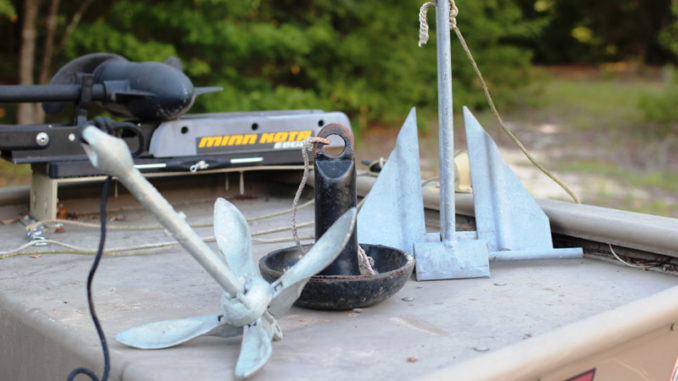
Grapnel, mushroom and fluke-style anchors all have their strong points
Anglers have a seemingly limitless choice of rods and reels, lures, hooks and lines from which to choose. And likewise, they have various options when it comes to anchoring. Just as some lures are better for certain situations, certain anchors are more suited for certain bodies of water. Wise angles know that the right anchor choice will make their day on the water far more productive and problem-free.
The three most common types of anchors are: mushroom, grapnel and fluke.
Mushrooms
Mushroom anchors get their name from their shape. They have no sharp edges and are best used in calm water like ponds and some lakes. They rely on weight alone to keep a boat in one spot. It only takes a 5-pounder to hold a typical bass boat. They are easy to store, cheap, widely-available and the easiest to deploy and retrieve. But they are limited to calm water.
Grapnel
Grapnel anchors are weighted anchors with four points – at least two of which will always be touching the bottom. They do a great job of digging into weeds, muck, rock, or whatever else the bottom is made up of. They are good for many bodies of water and can be purchased in various sizes or made using four pieces of rebar and some concrete. Good for most situations involving heavy current, they don’t work well on hard bottoms and can be difficult to retrieve when caught in rocks, branches, roots or other debris.
Fluke, a/k/a chene
Fluke, or chene, anchors are typically lightweight, with two sharp digging points. They range in size and weight, so they are a good option no matter what size boat you have. The sharp points dig into the bottom as the boat drifts with the current, stopping the boat once the anchor digs in solidly. The two points pivot from the shaft, allowing for easy deployment since it doesn’t matter what side of the anchor hits the bottom. These are great for offshore fishing or fishing in big rivers where current is always present.
Fluke anchors are the most versatile and several varieties are available. Some have a sliding ring that helps with retrieving, moving the pulling point up and down the shaft to get the anchor free from its anchor point. Others have shafts that pivot enough to make the anchor a straight line with a forceful tug to free even the most secure anchor-point. They can be tough to store, but most anglers feel they are worth the hassle.
A growing segment of anglers uses alternatives like the popular Power-Pole or anchoring sticks like the Stick It Anchor Pin, but some applications, like deep water, require a traditional anchor and will keep these around a long time.
Click here for more information on the importance of anchoring when fishing.



